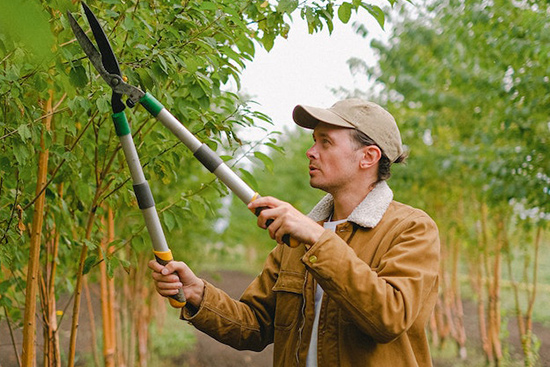Tree Thinning Tips That Keep Your Yard Safe, Healthy, and Sharp
Tree thinning is more than just trimming—it’s a strategic way to promote healthy growth, improve airflow, and prevent future problems. If your trees are thick, tangled, or blocking light, thinning them can make a big difference. This guide walks you through why thinning matters, how it’s done, and the long-term value it brings to your trees and yard.
What Is Tree Thinning?
Tree thinning involves selectively removing branches from the canopy of a tree. The goal is to open up the structure while maintaining its natural shape. It helps light reach the inner limbs and the ground below. Thinning reduces weight on heavy branches and keeps the tree balanced.
Unlike topping or over-pruning, thinning keeps the tree’s integrity intact. It focuses on health and structure, not just looks. Done right, it’s one of the best ways to keep mature trees thriving.
Why Thinning Matters
1. Improves Airflow
When air can move freely through a tree’s canopy, it reduces moisture buildup. This helps prevent mold and other diseases. Good airflow also keeps pests from settling in dense, damp areas.
2. Boosts Sunlight Penetration
Sunlight is essential for photosynthesis. Thinning lets more light hit the leaves inside the tree and the plants around it. That’s a win for your whole yard.
3. Reduces Risk of Falling Limbs
Heavy, crowded limbs can break during windstorms or snow. Thinning helps lighten the load and improve balance. This means less risk of falling branches that can damage property or injure people.
4. Promotes Healthier Growth
Thinning allows the tree to direct its energy to stronger limbs. It removes weak, crossing, or dead branches, which helps shape the tree and encourages healthy development.
Signs Your Tree Needs Thinning
Not all trees require thinning, but some show clear signs. Watch for:
- Branches rubbing or crossing each other
- Excessively dense canopies
- Lack of sunlight on the lawn below
- Storm damage or broken limbs
- Signs of fungal growth or pest infestations
If your tree is looking crowded or off balance, it’s time to thin.
Best Time to Thin Trees
The ideal time to thin a tree is late winter or early spring. During this period, trees are dormant, making it easier to see the structure. Cuts made in dormancy heal faster and are less likely to attract pests.
Avoid thinning in early fall. That’s when trees start preparing for winter. Trimming during this time can leave them vulnerable. However, light thinning or emergency cuts can happen year-round if needed.
Thinning of Tree Techniques
1. Start with Dead or Dying Branches
Remove damaged, weak, or dead limbs first. This clears the way and makes it easier to see what needs to go.
2. Thin the Crown Carefully
The crown is the leafy top of the tree. Aim to remove about 10–20% of the crown. Avoid taking too much—over-thinning can stress the tree.
3. Space Branches Evenly
Make sure remaining limbs are spaced out. This gives room for growth and prevents future crowding. Cut back branches that grow inward or rub others.
4. Cut Back to the Branch Collar
Always cut just outside the branch collar. This thickened area helps wounds heal. Never leave a stub or cut too close to the trunk.
5. Use the Right Tools
Use sharp, clean tools like bypass pruners, loppers, or a pruning saw. Clean cuts heal faster and reduce the chance of infection. Disinfect tools between trees to stop the spread of disease.
Benefits of Professional Thinning
While light thinning can be a DIY task, large or mature trees should be handled by experts. Arborists know how to thin without overcutting. They understand tree health, growth patterns, and safety standards.
Professionals also have equipment to handle high branches and heavy limbs. They can spot problems early, like rot or pests, that might go unnoticed otherwise.
Common Thinning Mistakes to Avoid
1. Topping the Tree
Topping means cutting off the upper part of the tree. This weakens structure and leads to poor regrowth. Avoid it at all costs.
2. Removing Too Many Branches
Thinning should always be selective. Cutting too much weakens the tree and exposes it to disease.
3. Ignoring Safety Precautions
Tree thinning involves sharp tools and tall ladders. Always wear safety gear and never work near power lines without professional help.
4. Thinning Too Often
Trees don’t need thinning every year. Most trees benefit from thinning every 3 to 5 years. Overdoing it can do more harm than good.
Long-Term Benefits of Thinning
Tree thinning isn’t just a one-time fix—it sets your trees up for long-term success.
1. Stronger Trees
By guiding growth and reducing weight, thinning strengthens limbs. This helps them withstand weather better and live longer.
2. Better Landscaping
Thinned trees allow light to filter through, which benefits your lawn, garden, and nearby plants. It makes your whole yard feel more open and balanced.
3. Safer Property
Thinned trees pose less of a hazard in storms. They’re less likely to drop limbs or get uprooted.
4. Lower Maintenance
Healthy trees need less intervention. A properly thinned tree will grow in a more manageable shape, reducing the need for major work later.
Conclusion
Tree Thinning and Pruning is a key part of tree care that improves health, safety, and appearance. It allows more sunlight and air to flow through, reduces risk, and promotes growth. Whether you do it yourself or call in a pro, thinning helps your trees grow better and last longer. Use these tips to maintain a yard that’s healthy, open, and beautiful.
Ready to improve your yard’s health and safety? Choose expert tree thinning services to boost growth, improve airflow, and keep your trees strong and attractive all year.


